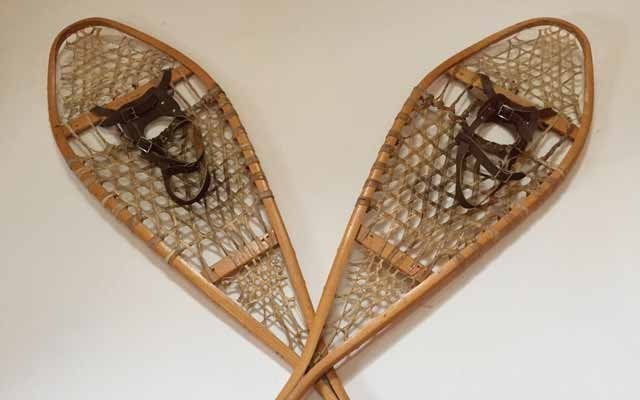Long before I became a skier I was a snowshoer. With my cat-gut-strung, wooden-framed raquettes (in the blunt-tipped Algonquin style as opposed to the pointed Iroquois or rounded Bearpaw varieties) I trudged the woods near our family cabin in Ontario, fancying myself a modern-day courier du bois. Modern snowshoeing this was not; rather, the full-on old-school approach was the only reliable way to traverse bottomless snow with no trails to aid you. When, as a teen, I discovered you could do this on touring skis, my snowshoes fell into a familiar kind of retirement: relegated to a spot over the fireplace. And while I couldn't quite comprehend the modern resurgence of snowshoes as de facto winter sports gear, I well understood the history of these Canadian icons. I never forgot that it was these marvels of indigenous invention that introduced me to the solitude of the winter woods, where only the scatter of animal tracks and creaking trees provide company.
Snowshoeing has since become a popular sport, with a range of smaller, faster versions crafted of modern lightweight materials, ready-made for both trail and off-trail pursuits. They're perfect for dedicated summer hikers and runners who crave an aerobic winter stroll but aren't keen on all the balance-challenging learning curves of skiing. Like skiing, however, if you walk off uninformed into the mountains on snowshoes, you're as likely to die as have an enriching experience. Knowledge of how, where, and when to go is key, which is why someone has finally penned a guidebook for just that.
Published by Rocky Mountain Books, Snowshoe Trails in Southwestern British Columbia by Vancouverites Aileen Stalker and Tony Keen is a first such comprehensive guide to this area that will not only keep you out of trouble, but deliver the snowshoe goods (is that term even transferable?).
"I'm retired now but like to keep myself busy," Stalker tells me on the phone. "We'd been hiking certain trails in summer and snowshoeing them in the winter for about 15 years. But we were doing the same ones over and over and began looking for more. My son sent me to the Interpretive Forest in Whistler, where we found many great trails, which inspired me to get out there and start finding more. Then he suggested I put together a book of all the new trails we were doing."
The medium-sized volume is set up like most guidebooks with a "Getting Started" section that plumbs history, safety, equipment, clothing, and technique, followed by trail listings for the Coquihalla, Fraser Valley, Manning Park, North Shore, Sunshine Coast, Sea to Sky (non-Whistler), and a couple sections for Whistler itself. Each trail description details where and how to find it, what it's like, its hazards and appeals. There are shorter bits on other regions of the province and the contiguous United States, as well as extensive appendices.
It took five years to put the guide together, mostly because each trail had to be snowshoed at least three times to see how it worked in different conditions and to get GPS coordinates for the guide's accompanying maps. In addition, research was required for the various sidebars and to flesh out safety aspects. "The greatest challenge was when I decided to put in distances, because how long it takes to get from one point to another is an important question to ask yourself in the winter," she says.
"All the years we were trying new trails I was increasingly aware of the winter safety component most snowshoers don't take into account — falling, getting cold, wet, and tired — that aren't really issues in the summer," says Stalker. "People needed a guide to tell them distances and where to turn if they couldn't see the summer markers (generally set too far apart for winter because you're following a trail in summer). Direction is a real safety concern in winter."
Especially with the number of snowshoers increasing exponentially (check out the ever-growing wall of snowshoes in MEC stores and those in Whistler). In Vancouver, the North Shore mountains are overused and come with complex terrain and considerable avalanche danger, so parks would love for people to go other places. Now they have a guide to do just that.
"All the trails we list are easy and intermediate, because harder backcountry trails require avalanche and first aid training," notes Stalker.
She is boundlessly enthusiastic, giving talks about the sport's appeal. "It's healthy and highly aerobic, especially if you're using poles, then it's like Nordic walking. It's adaptable to any age and ability, and you can have a baby in a backpack, or pull a toddler toboggan. Teenagers will come as long as you bring enough food for them, and you can still snowshoe in weather that shuts down skiing. It's low impact and low cost, and so something you can return to as you get older."
The kicker, however, is something I'd never thought of. "If you're really a hardcore backcountry ski guy but your girlfriend isn't, take her out snowshoeing and make the chocolate fondue recipe in the guide — it's equivalent to giving her a bouquet of flowers."




